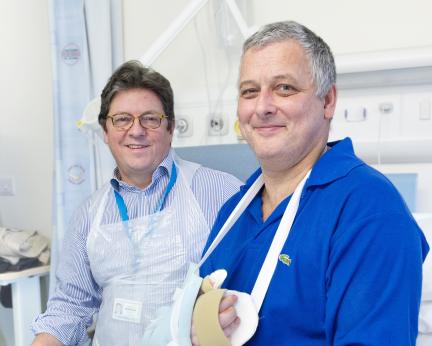I work in both the children’s and adult hand clinics and see patients referred from all over the UK and Europe. The range of conditions we treat is very varied. These include adults with upper limb nerve and vascular problems. The surgery is very complex and I work closely in a multidisciplinary team alongside vascular surgeons, radiologists, neurosurgeons, orthopaedic surgeons, paediatricians, physiotherapists and clinical psychologists. Collaborative working is vital.
I run an adult hand surgery outpatients clinic once a fortnight when I usually see between 18 and 25 patients with my colleagues. The team is not hierarchical and I always listen to the views of junior surgeons who will often be very well-informed about the latest techniques. We often ask one another for help.
The operations I perform are often very difficult and time-consuming. However, I don’t see my patients as technical problems – I’m also interested in their personal situation and the problems they are facing as a result of their condition. We need to understand the psychological aspects of hand injury and deformity, which is why a psychologist usually participates in my outpatients’ clinics.
The technical aspects of the surgery are naturally very important. However, the human hand is so much more than just a part of the body which has physical functions such as grasping and pinching. There is both beauty and power in the human hand, and it has a vital role to play in communication.
Our children’s hand surgery clinic is the largest in the UK. I usually spend half a day a week with my young patients in the outpatients’ clinic. Children’s hand problems are divided between birth deformities such as missing digits and birth injuries, where the nerves are damaged during delivery. I generally see babies from the age of 12 weeks onwards.
Reconstructive surgery may involve replacing a missing digit from the hand. At Leeds Teaching Hospitals we have pioneered the transfer of digits from the child’s own body. For example a missing finger or thumb can often be replaced with a toe to create a functioning hand. I occasionally operate on newborn babies, but more often surgery on infants takes place between four and seven months of age.
I also run a transplant hand clinic about once every two to three months.
About two days a week are spent in surgery – I usually start operating at around 9.00 am and finish between 4.30 and 5.00 pm. The operations vary in length from an hour and a half to seven hours or longer. Again, my work is highly collaborative and I work closely with surgeons from different specialties.
Preparations for our recent double hand-transplant surgery started the day before the operation when we heard a suitable donor was available. The patient, who had been waiting two years for his surgery was invited into hospital where he was given immunosuppressant drugs. Surgery began by indentifying structures in the stumps of the patient’s hands and preparing the donor hands before the transplant.
This operation, which was the first of its kind, took ten hours to perform. Eight consultant plastic surgeons were involved in four teams, with two teams working on each hand, one for the transplanted hand and one for the stump. All the junior surgeons in our department were also able to observe and participate.
Another important part of my work is teaching and lecturing at Leeds and Bradford Universities. My current research is a clinical evaluation of transplantation. I’ve also spent twenty years as honorary visiting professor at Umea University in Sweden, which I visited two or three times a year. I’m also editing a text book on plastic surgery and I teach postgraduate students all over the UK.





